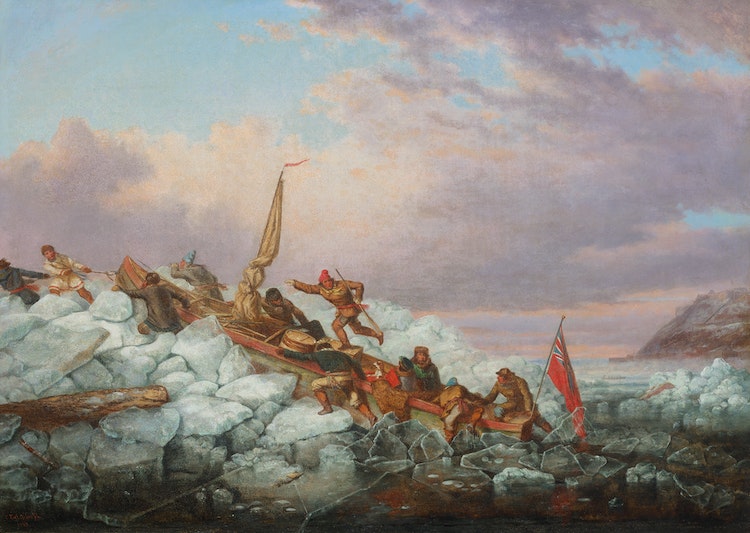Cornelius Krieghoff moved to Quebec City in 1853, encountering a vibrant and growing city. As Dennis Reid remarked: “Almost as large as Montreal at a population of some 58,000, close to 40 per cent anglophone (as opposed to the then slightly more than 50 percent anglophone component of the Montreal population) it was the military headquarters for British North America, the centre of the all-important timber trade with Britain, the location of the burgeoning new ship building industry and since October 1851, had been the seat of the government for the province of Canada.”

While pioneer life was rugged and precarious, it was also a productive and fruitful time for Krieghoff as he recorded the industry and ingenuity of the people of Quebec City. At this time, there was no bridge over the St. Lawrence River, and so to cross this mighty body of water to access Lévis on the opposite shore, one had to embark upon a perilous journey in a Royal Mail canoe. Marius Barbeau, Krieghoff’s early biographer, points out that, “The cutting of lumber in the woods and the driving of rafts down the Ottawa and the St. Lawrence gave rise to a great Canadian industry in the earlier part of the nineteenth century, and Krieghoff, like his predecessor Bartlett, interprets some of its aspects upon canvas.”
Few would embark upon this journey across the St. Lawrence River in a Royal Mail canoe unless necessary. Passengers had to lay down or seat themselves in the canoe, which was manned by ten or twelve people. The canoe would be paddled through the open water amidst floating islands of ice. This crossing would take hours and was dangerous, with the passengers often reaching a shoreline that was miles beyond the point at which they had started. According to J. Russell Harper, “The boatmen or canotiers who operated these were a hardy breed who jumped out on the ice floes which impeded their progress and hauled the wooden canoes over the obstacles. Some passengers who gave them a hand received a reduction in their passage money. It was an adventurous trip for the uninitiated, and one of the experiences remembered by visitors to Quebec in the winter months.”
Krieghoff has chosen to depict a heightened scene of drama in this composition of a Royal Mail canoe making its crossing at winter. This canoe bears the responsibility of safe passage for eleven people, which includes a woman seated on a bearskin rug holding her dog, secured in the back half of the vessel. The citadel and ramparts of Quebec City are silhouetted in the distance, anchoring the scene. The energy and hard work involved in this venture, as well as the frenzy and cold nature of the excursion vibrates from the canvas. The boatmen are hustling to pull and push the boat over the ice floes before the vessel freezes in place, while one worker blows a horn signalling their position in the river. No one aboard the Royal Mail canoe seems particularly alarmed by what appears to be an experience that could have an uncertain outcome.
Krieghoff specialized in genre paintings, and this work is a remarkable anecdotal image of the human struggle against ice floes and the ferocity of the upper St. Lawrence River in the depths of winter. Barbeau lists six known versions of this subject, painted between
1859 and 1862. “Under his vivid brush they are alive with fun and movement,” stated Barbeau. A similar variant to this 1860 canvas is “Crossing the St. Lawrence with the Royal Mail at Quebec,” an 1859 canvas in the collection of the Sobey Art Foundation. Krieghoff is known to have painted more than one of the same image in various canvas sizes and also recognized the commercial benefit of lithography, a popular endeavour in this period. A lithograph of a Royal Mail canoe making the arduous St. Lawrence River crossing was produced from one of Krieghoff’s versions of the painting, but the citadel of Quebec City was eliminated.
Krieghoff visited Montreal around the time of the erection of the Victoria Bridge between 1854-59 and sold one of his canvases of the Royal Mail canoe crossing to an engineer working on the project. When a book was issued on the development of this ground-breaking new bridge, Construction of the Great Victoria Bridge in Canada, illustrations demonstrating the inadequacy of the boats used to cross the river in Montreal were included, highlighting the convenience of the new bridge. Krieghoff’s painting of the Royal Mail canoe crossing was included. However, this reproduced image removed the Quebec citadel from the horizon line, declaring the depiction to be in Montreal, thus strengthening the case for the triumph of the Victoria Bridge.
Krieghoff was an artist attuned to the interests of his audience and was beloved by collectors during his lifetime. The legacy of “The Royal Mail Crossing the St. Lawrence” as a treasure within his artistic oeuvre is further solidified by the rarity of a canvas with such an abundance of figures, exquisitely rendered detail and narrative strength. Krieghoff produced dignified paintings that were romantic in nature, evoking the deep roots of the people he encountered and imparting his own vision of historical Canada. Reid argues for “the complex genesis of Krieghoff’s images of Canada”, in which this canvas holds a prominent place.

